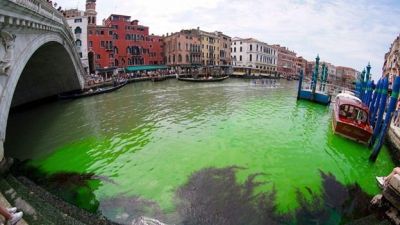Venetians witnessed a strange sight in late May, as a patch of water in the city's central waterway appeared to have turned fluorescent green. Local authorities collected water samples and opened an urgent investigation. Speculation is rife as to what might have caused the water around the famous Rialto Bridge to change color. Theories range from the release of dye to a protest by environmental activists. Italian media reported that local police were examining CCTV to determine whether the release might have been a stunt to coincide with the Volgalonga regatta taking place the following weekend. In an interview with Italian daily La Repubblica, Maurizio Vesco of the Regional Agency for Environmental Protection said that early analysis indicated that the green patch was likely caused by the release of fluorescein, a harmless dye commonly used to track the flow of water. While this substance is not uncommon, Mr. Vesco said that the usual dosage was one spoonful of dye powder - yet the size of the patch suggested that at least 2 pounds had been dumped in the waters. "I find it hard to believe that it was an incident...and that [2 pounds] of fluorescein was casually released into the canal," he told La Repubblica. Many social media users said the images coming out of Venice were remindful of the 1968 stunt by Argentine artist Nicolás García Uriburu, who dyed the waters of the Grand Canal green in order to raise awareness of ecological issues.
I veneziani hanno visto a maggio una cosa strana mai vista prima. C'era un'ampia sezione nel centro dell’acqua di colore verde fluorescente vicino al Ponte di Rialto. Le autorità hanno raccolto molti campioni d'acqua per un'indagine urgente. La ricerca non è stata conclusa. Ci sono una varietà di teorie che includono la tintura messa nell'acqua come una manifestazione degli attivisti ambientali. Un'altra teoria, su cui la polizia sta indagando, è che il colorante sia stato messo in acqua in coincidenza della regata della Vogalonga la settimana scorsa. In un'intervista con Maurizio Vesca a La Repubblica, ha detto che forse il colorante potrebbe essere la fluoresceina, un colorante innocuo che a volte è messo nell'acqua per monitorare il flusso dell'acqua. Vesca lavora per un'agenzia locale per la protezione dell'ambiente. Anche se la fluoresceina è normale da mettere in acqua, di solito è sufficiente mettere un cucchiaino in acqua, ma il colore dell'acqua e la larghezza dell'acqua fluorescente mostra che più di 900 grammi di questa sostanza sono stati versati nei canali. Sui social media, le persone hanno pubblicato post che ricordano la situazione quando Nicolas Garcia Uriburu, un argentino, ha messo la tintura verde nelle acque veneziane, in particolare sul Canal Grande, per aumentare la consapevolezza ambientale nel 1968.



